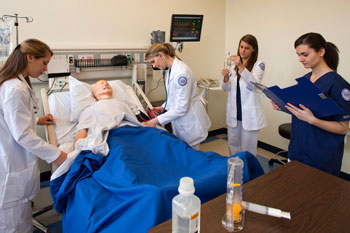
The Bachelor of Science in Nursing program at Longwood University is now accredited by the Commission on Collegiate Nursing Education.
Established in 2009 to develop well-trained, career-ready nurses to help fill the regional and nationwide nursing shortage, Longwood’s nursing program works in concert with local health care providers and in a state-of-the-art clinical simulation lab to provide community-oriented instruction for students. An evaluation of the program by the CCNE review team in November indicated that "there are no compliance concerns and that all standards were met" for accreditation.
"This was truly a team effort by the Longwood faculty, students, administration and the community," said Dr. Melody Eaton, chair of the nursing department. "It’s confirmation that Longwood’s nursing program is able to instruct students in a complete way for their careers in the field. This program has grown by leaps and bounds since its inception, and we were able to prepare 25 compassionate, intelligent professionals for their board exams and entrance into the profession." Reports from clinical sites indicate Longwood students are exceptionally prepared, she said.
The nursing program continues to grow in its fifth year, admitting 50 students this fall for the class of 2017 from hundreds of applications. As the only state university that offers a BSN in a 60-mile radius, the program has a unique place in the community and commonwealth as health care needs continue to grow.
The uniqueness doesn’t stop there. Longwood’s nursing program is different in that students are admitted directly into the program as freshmen, beginning their clinical practice and gaining valuable experience in some cases years before their peers at other institutions. Most nursing programs require one or two years of general study before students apply for admission.
Longwood’s nursing program graduated its first class of 25 students in May 2013. More than half already have jobs lined up at hospitals around Central and Southside Virginia in a variety of clinical settings, including trauma centers, operating and emergency rooms, and birthing centers.

